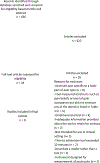Multidimensional Pain Assessment Tools for Ambulatory and Inpatient Nursing Practice
- PMID: 32448737
- PMCID: PMC7554114
- DOI: 10.1016/j.pmn.2020.03.007
Multidimensional Pain Assessment Tools for Ambulatory and Inpatient Nursing Practice
Abstract
Background: One of the critical components in pain management is the assessment of pain. Multidimensional measurement tools capture multiple aspects of a patient's pain experience but can be cumbersome to administer in busy clinical settings.
Aim: We conducted a systematic review to identify brief multidimensional pain assessment tools that nurses can use in both ambulatory and acute care settings.
Methods: We searched PUBMED/MEDLINE, PsychInfo, and CINAHL databases from January 1977 through December 2019. Eligible English-language articles were systematically screened and data were extracted independently by two raters. Main outcomes included the number and types of domains captured by each instrument (e.g., sensory, impact on function, temporal components) and tool characteristics (e.g., administration time, validity) that may affect instrument uptake in practice.
Results: Our search identified eight multidimensional assessment tools, all of which measured sensory or affective qualities of pain and its impact on functioning. Most tools measured impact of pain on affective functioning, mood, or enjoyment of life. One tool used ecological momentary assessment via a web-based app to assess pain symptoms. Time to administer the varying tools ranged from less than 2 minutes to 10 minutes, and evidence of validity was reported for seven of the eight tools.
Conclusions: Our review identified eight multidimensional pain measurement tools that nurses can use in ambulatory or acute care settings to capture patients' experience of pain. The most important element in selecting a multidimensional pain measure, though, is that one tool is selected that best fits the practice and is used consistently over time.
Copyright © 2020 American Society for Pain Management Nursing. Published by Elsevier Inc. All rights reserved.
Conflict of interest statement
Figures
References
-
- Becker J, Schwartz C, Saris-Baglama RN, Kosinski M, & Bjorner JB (2007). Using Item Response Theory (IRT) for developing and evaluating the pain impact questionnaire (piq-6tm). Pain Medicine, 8(S3), S129–S144. doi:10.1111/j.1526-4637.2007.00377.x. - DOI
-
- Cella D, Riley W, Stone A, Rothrock N, Reeve B, Yount S, Amtmann D, Bode R, Buysse D, Choi S, Cook K, Devellis R, DeWalt D, Fries JF, Gershon R, Hahn EA, Lai JS, Pilkonis P, Revicki D, Rose M, Weinfurt K, Hays R, & Group PC (2010). The Patient-Reported Outcomes Measurement Information System (PROMIS) developed and tested its first wave of adult self-reported health outcome item banks: 2005–2008. Journal of Clinical Epidemiology, 63(11), 1179–1194. doi:10.1016/j.jclinepi.2010.04.011. - DOI - PMC - PubMed
-
- Centers for Disease Control and Prevention. (2014). The cost of arthritis in us adults. Retrieved from https://www.cdc.gov/arthritis/data_statistics/cost.htm (Accessed 11 December 2019).


